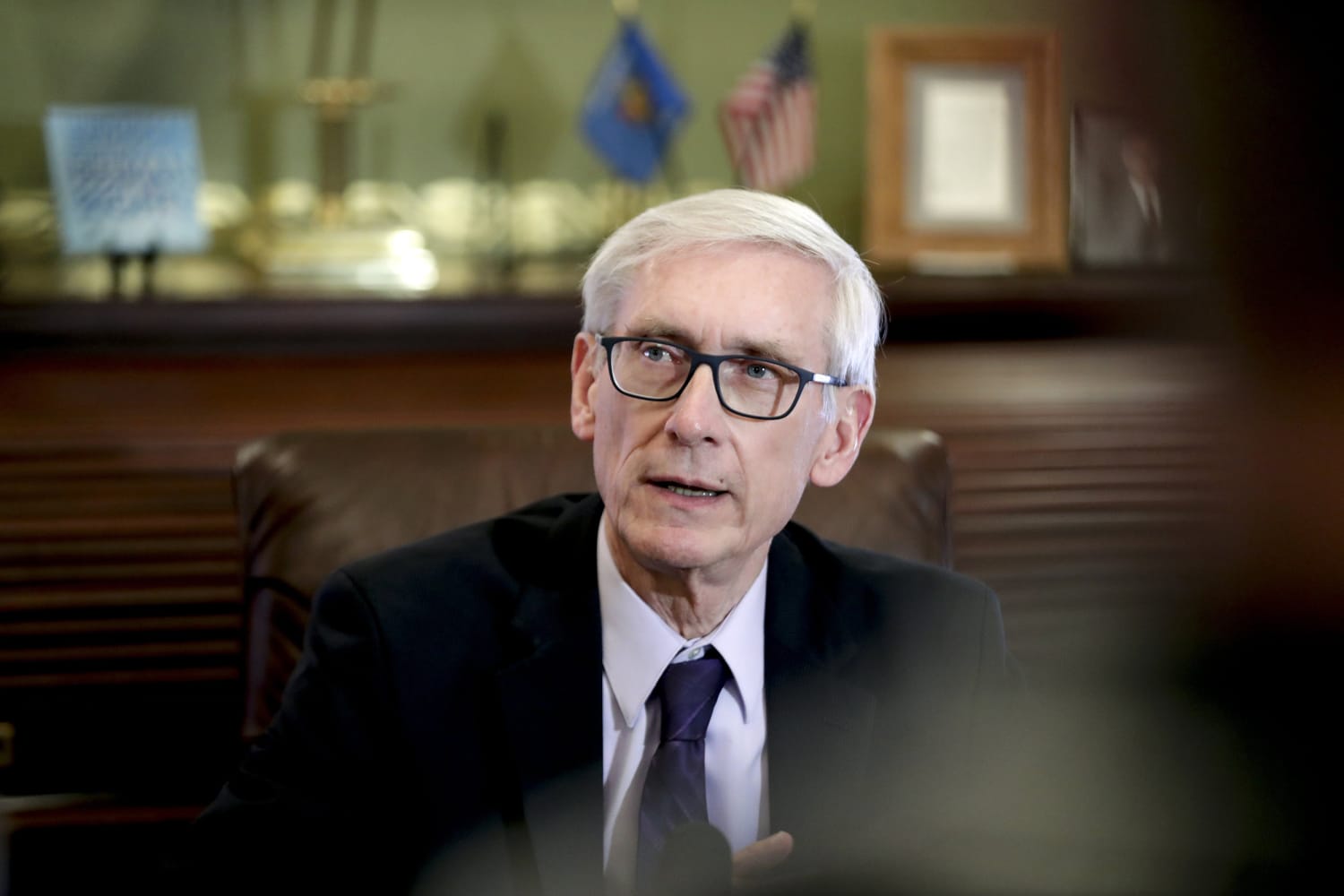
At one point during the pandemic, Black residents of Milwaukee County were six times more likely to die from the coronavirus than Wisconsin’s white residents, state health officials said.
The state’s governor, Tony Evers, a Democrat in his first term, issued a mask order and other mandates to protect all citizens, but the Republican-led legislature successfully sued to strike down those decisions.
The more Evers fought for Covid-19 restrictions, the more GOP resistance he faced inside the state Capitol. The state Supreme Court issued several decisions siding with Republicans in limiting Evers’ power to act during a public health emergency.
“It’s pretty shameful they didn’t want to act or didn’t seem concerned with the loss of life toward Blacks and Latinos,” Lt. Gov. Mandela Barnes, a Democrat, said. “It seemed like they could care less.”Full coverage of the coronavirus outbreak
In truth, Evers was facing an uphill battle long before being elected in 2018.
The Republican dominance over the state began when the party discreetly redrew and tilted state legislative and congressional district maps in 2011, soon after the U.S. census, giving the state GOP an advantage over Democrats for another decade.
The move was “one of the most effective gerrymanders that you can imagine — barely any seats have changed hands in terms of party control,” said Anthony Chergosky, an assistant professor of political science at the University of Wisconsin-La Crosse.
Although Wisconsin traditionally splits its vote evenly between the two parties, Democrats haven’t had a shot at taking the majority since the redistricting, Chergosky said.
Republicans are standing firm in defending the legislative maps. They point to cases such as Patrick Testin, a Republican state senator and now president pro tempore, who was elected in 2016.
His Democratic predecessor won Senate District 24 by 13 points in 2012, but four years later, it flipped for Testin, who won by 4 points.
“The district hadn’t elected a Republican since 1968,” Testin said. “What that tells is me that while the geographic lines didn’t change from 2012 to 2016, the people’s opinion changed.”
Rick Esenberg, president of the Wisconsin Institute for Law & Liberty, a conservative think tank that sued the state over Evers’ mask mandate, said that the way districts were drawn can’t be called unfair “because Democratic votes are geographically concentrated — the Democratic votes come from Milwaukee and Madison,” the state’s two biggest cities.
“There’s no way to tell whether or not the efficiency gap is too high,” Esenberg said, referring to measuring partisan gerrymandering.
The gerrymandering that solidified Republican dominance of the Legislature, however, has stifled any chance Evers had of responding quickly and effectively to the pandemic, according to Evers’ staff, a price paid by Wisconsinites who caught the coronavirus, and in disproportionate numbers by the state’s Black and Latino residents.
More than 6,100 people in the state have died from the coronavirus and another 580,000 have been infected.
The governor’s staff has accused Republicans of using their unyielding power to work against every effort by Evers to keep the state’s residents healthy and safe as other GOP legislators nationwide put politics aside for their constituents.
For example, before the state presidential primary election in April, the governor suspended in-person voting and ordered the state Legislature to convene amid concerns about the pandemic.
The purpose was to allow an all-mail election and to send a ballot to every registered voter who hadn’t requested one.
The Republican-controlled Legislature didn’t take up the issue.
Evers was later rebuffed when Republicans took him to court and the Wisconsin Supreme Court struck down the order to suspend in-person voting.
Despite federal guidelines to social distance and avoid crowds, thousands of voters jeopardized their health and safety by going to the polls to vote, and some later tested positive for the coronavirus.
The following month, the state Supreme Court overturned Evers’ stay-at-home order in a 4-3 decision, arguing that he had overstepped his authority.
Nearly 70 percent of Wisconsinites thought it was appropriate to close schools and businesses and restrict public gatherings to fight the spread of the virus, according to a Marquette University Law Poll released in May.
Also, 53 percent of state residents trusted the governor more than the Legislature to decide when it came to reopening and easing Covid-19 restrictions, the poll found.
Evers has declared at least three public health emergencies and issued other coronavirus-related orders that have all been met with Republican resistance.
Almost 20 percent of Wisconsin’s coronavirus deaths have been in Milwaukee County, which has had nearly triple the number of deaths as the next highest county, Waukesha, and Milwaukee County has had almost 100,000 infections, more than double that of the county with the second highest total. Milwaukee County has about 16 percent of the state’s total population, but 70 percent of its Black population.
“You could see those disparities in underserved communities,” said Benjamin Weston, director of medical services for the Milwaukee County Office of Emergency Management. “Unfortunately, it wasn’t surprising the way that Covid highlighted the inequities in different communities.”
With every disease, it’s predictable that Black and Hispanic people will be hit hard, said Weston, also the medical director for the Unified Emergency Operations Centers, a collection of health and emergency systems coordinating the Covid-19 response.
He added that the gap between the virus’ impact on those communities and others has closed somewhat since the pandemic started.
“The disparities aren’t quite there anymore,” Weston said. “The numbers have settled down as Covid has spread.”
Nationally, low-income Black people are more likely to contract the coronavirus because of inequitable access to health care and education, living in more densely populated areas and being more likely to work on the front lines, medical experts say.
The city of Milwaukee is predominantly Black, underserved and among the most segregated metropolitan areas in the country. Once it was a thriving blue-collar city big on manufacturing heavy machine equipment, including Harley-Davidson motorcycles, cranes, and mining shovels.
“The city became known as the machine shop of the world,” said John Gurda, an author and Milwaukee historian.
The nationwide recession in the early 1980s led to a collapse. Poverty rates soared. Milwaukee lost 25 percent of its manufacturing jobs, the majority of which were occupied by Black workers. Segregation molded into place, Gurda said.
“Systemic racism is as alive here as anywhere else,” he said, noting that several restrictive zoning covenants and redlining ensured Black residents couldn’t venture to the suburbs with white residents.
Usually, poor communities like this lean Democratic, but some say their voices aren’t always fairly heard.
“The 2011 Wisconsin Assembly districts surrounding Milwaukee show evidence of cracking, one method of electoral gerrymandering,” although it’s not definitive if any seat flipped after the redistricting, according to a 2018 report from WisContext, which tracks assembly voting maps.
When the lines were redrawn in 2011, Milwaukee County was broken into small pieces, each one tied to a largely white, Republican-voting area.
“People in Wisconsin are more interested in the candidate and not the letter behind the candidate’s name,” Testin, the Republican state senator, said. “It really comes down to finding good candidates to reflect their districts, and we’re willing to put in the work.”
Back at the state Capitol, the Wisconsin Senate is made up of 20 Republicans and 12 Democrats, with one vacancy.
Separately, the Assembly consists of 60 Republicans, 38 Democrats, and one vacancy.
The full-time Legislature hasn’t passed a bill in several months, hampering the governor’s ability to take action against the pandemic.
It’s led to nasty showdowns between Evers and the Republicans, Chergosky said.
Since redistricting 10 years ago, Democrats have captured fewer seats in the Statehouse even when winning roughly the same amount of votes as their Republican counterparts.
In one of many lawsuits, Gill v. Whitford, Republicans were accused of drawing up districts in a way that violated the constitutional rights of Democratic voters.
In 2016, the U.S. District Court for the Western District of Wisconsin concluded that the redistricting discriminated against Democrats, and that the Republicans would maintain a decisive advantage despite a strong Democratic showing at the polls.
The appeal went to the U.S. Supreme Court, in a case billed as one that could reshape American politics. The justices sent the case back to the lower court.
“It told mapmakers you can do whatever you want,” said Barry Burden, a political science professor at the University of Wisconsin-Madison. “All of the guardrails are off.”
It would take an incredible Democratic wave at the ballot box for Republicans to lose their majority, and that leads to the state’s coronavirus response and the Legislature’s inaction, Chergosky said.
State Assembly Speaker Robin Vos, a Republican who was influential in the redistricting plan, didn’t return phone calls seeking comment for this article.
In a 2019 statement after the Supreme Court’s ruling, however, she said that the court had “confirmed what we have said all along — that it was not a matter for the federal courts to second guess the Legislature on these issues,” The Associated Press reported.
With the 2020 census over, this year brings about new redistricting plans, and Democrats are saying they want more transparency this time around.
“Wisconsinites don’t want maps that favor any political candidate or party — we just want maps where either candidate can win. Folks, that’s just common sense,” Evers said this month in his State of the State address, WMTV, an NBC-affiliated station in Madison, reported.
Vos, however, said the process “might not be the one that Governor Evers wants, where his hand-picked liberals have the ability to try to draw maps that will somehow help them at election time,” WMTV reported. “We prefer to go through the process like we have every year before, where we have a chance to draw the maps [and] we also have a chance for public input.”
In another sign of state Republicans trying to extend their influence, they are proposing changing how the state allocates electors in the presidential contest, with Rep. Gary Tauchen having circulated a bill this month, NBC News reported.
If passed, one elector would be allocated for every congressional district a candidate wins, with two additional electors allocated to the statewide winner, meaning the winner of the statewide popular vote wouldn’t be guaranteed all the state’s electoral votes.
Evers has been criticized during the pandemic, most recently for the slow rollout of vaccinations. About 266,000 people in the state have been vaccinated, according to the Wisconsin Department of Health Services. That makes it among the 10 states with the lowest per-capita vaccination rate.
Evers last week declared a new public health emergency extending the statewide mask mandate for another two months. A Republican challenge to the mandate is being heard in state Supreme Court.
Source: | This article originally belongs to Nbcnews.com










